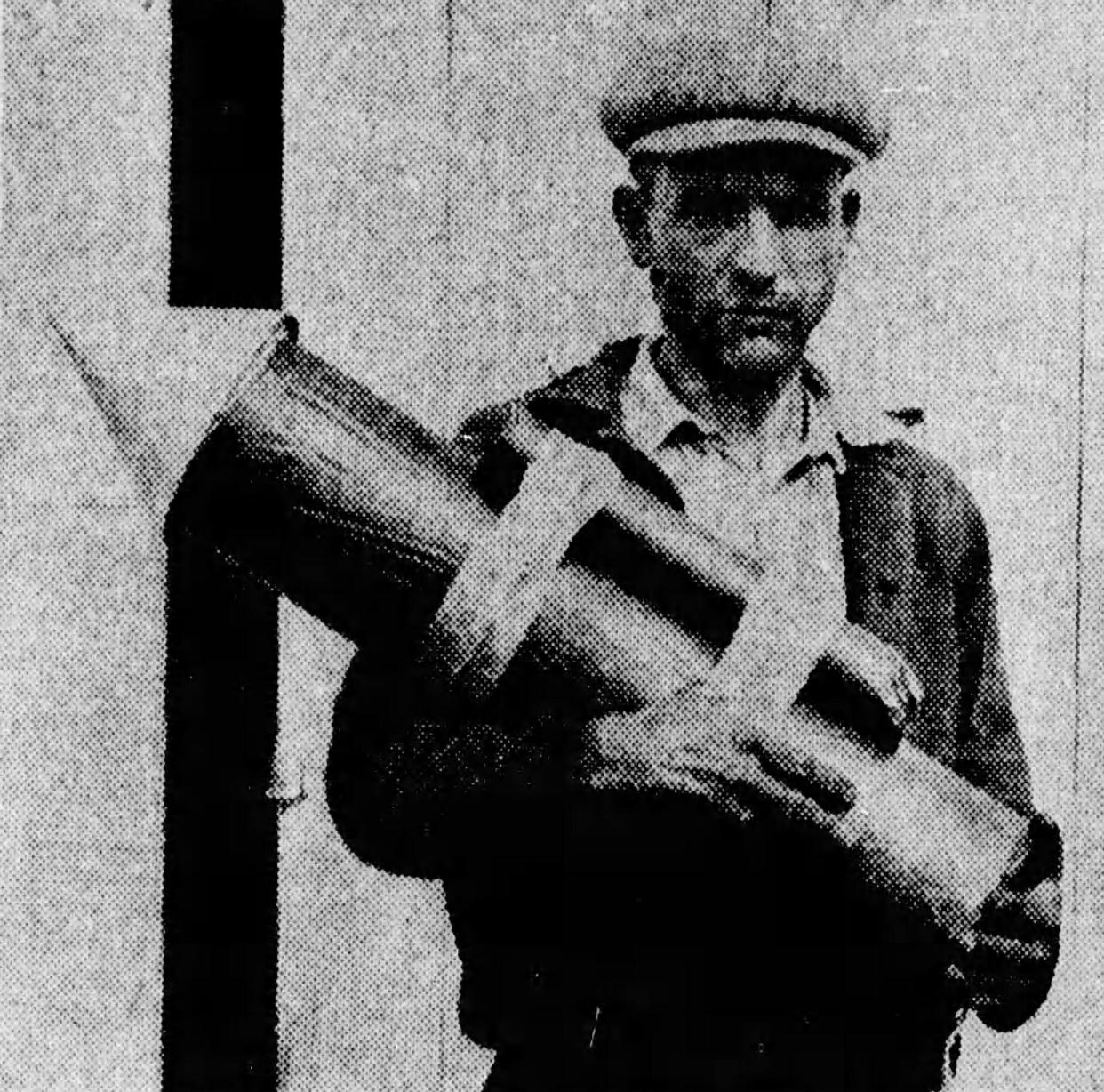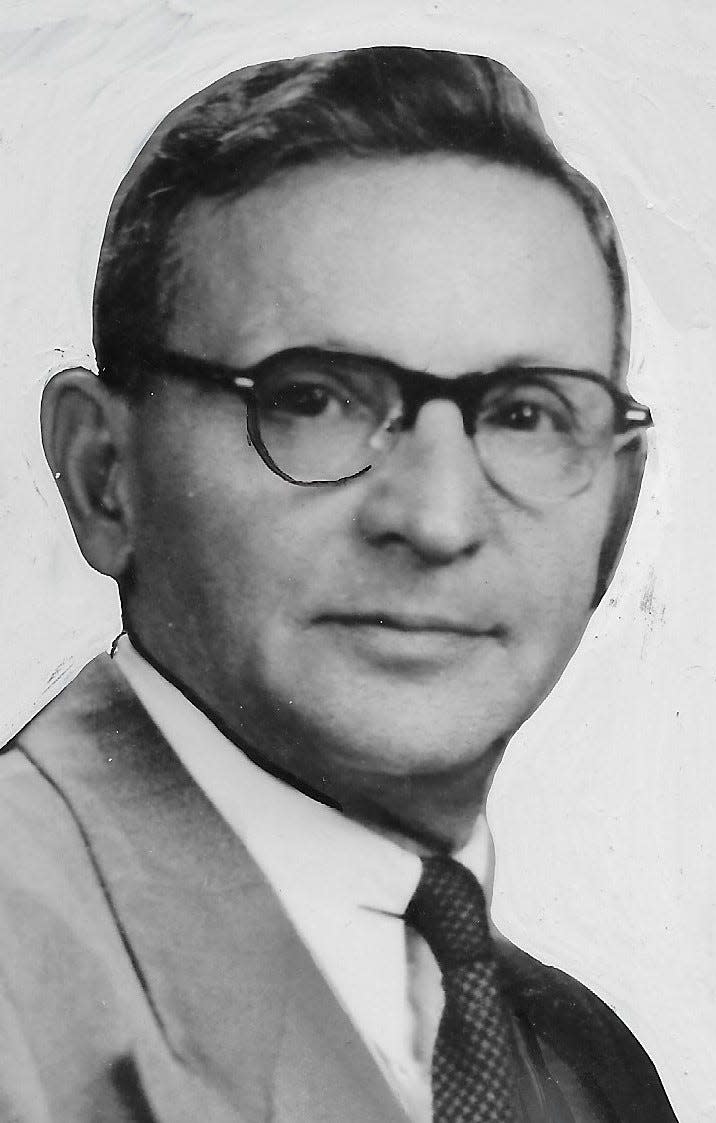Local history: Hudson fireworks maker planned trip to moon in 1929

- Oops!Something went wrong.Please try again later.
Jim Sorgi always aimed high.
The Hudson fireworks manufacturer gained international fame in 1929 when he proposed building a rocket to the moon.
Local history: The night that Glendale Cemetery exploded
Local history: People lined up to see Apollo 11 moon rock in 1971
Sea World revisited: Vintage photos of Ohio marine park
“I can do anything once I get it on my brain, and I got this idea on my brain very much,” he told reporters.

Some people laughed at him. Some called him crazy.
“That’s what they say, but I want to be crazy that way,” Sorgi said.
Besides, he said, people originally thought that Dayton brothers Orville and Wilbur Wright were nuts, too.
“Now every day I look up and see airplanes, and there are no wires to hold them up,” Sorgi said.
The Ohio businessman was ahead of his time. He advocated space travel nearly 30 years before the Soviet Union launched Sputnik and 40 years before the United States landed on the moon.
Fireworks family from Italy
Sorgi, 43, had been making fireworks since he was a little boy in Italy. Born Vincenzo Sorgi in 1886, he grew up in the city of Avezzano in the Abruzzo region. His father operated a fireworks shop that had been in the family for three generations.
In 1904 when he was 18, Sorgi immigrated to the United States. He landed a job as a water boy and ditch digger for a crew laying out Pennsylvania Railroad tracks from Alliance to Cleveland. Co-workers had trouble pronouncing “Vincenzo,” so they called him “Jim,” and the name stuck.
Sorgi learned English and saved a little money. When the railroad line reached Hudson, Jim liked the New England-style town so much that he stayed. He operated a fruit cart, a shoeshine parlor and a grocery store before returning to his family roots.
In 1917, Sorgi and his brother-in-law A.J. DiMichele formed a fireworks company. A year later, the partnership dissolved with Sorgi establishing the American Fireworks Display Co. north of Hudson and DiMichele founding the Hudson Fireworks & Display Co. south of the city.
The fireworks business was booming in the 1920s. The Hudson companies produced more than 100 shows per year across the country.
Sorgi liked to tinker with fireworks at his compound, trying to find ways to improve the pyrotechnics. Friends called him “Jimmy the Bomb.”
And then he glanced at the moon. It was more than 238,000 miles away.
Wouldn’t that be something?
“I want to do something that nobody has ever done before,” he said.
Rockets launched in Hudson
For months, he experimented. He built bigger and bigger rockets with more and more powder. Sorgi envisioned a giant rocket that would be propelled by a series of explosions. Timed fuses would be connected to a series of powder chambers. Each explosion would take the vessel higher.
Sorgi constructed a 3-foot rocket with a 50-pound charge. He planned to work his way up from 50 to 100 to 150 to 200 to 250 pounds until he produced a rocket that would go to outer space.
“I could build that giant rocket now, but I don’t want to send it up till I know just what it will do,” he told the Akron Times-Press. “By increasing the size gradually, I’ll find out. Then we’ll fly in them.”
Sorgi launched a rocket that crashed to earth after climbing about 1,000 feet. A second rocket disappeared from view after takeoff. He never did find that one.
During his experiments, Sorgi strapped a small rocket to an old automobile and lit the fuse. The vehicle hurtled across a 10-acre field and disappeared in the woods. He found it upside-down against a tree.
“I’m going to build that rocket if it takes the last cent I got,” he said.
The inventor said a passenger would ride in a glass-enclosed basket attached to the side of the rocket, similar to the passenger cabin of a zeppelin. Should an emergency landing be necessary, a parachute would open and the rocket would float to the ground.
Sorgi acknowledged that he still had a lot of things to figure out.
“I’ll have to work out a system of insuring air for the passenger,” he noted. “This will be hard because unless it’s worked out just right, the air pressure would kill the passenger.”
Sorgi vowed to ride the vessel himself if no one else wanted to do it.
“The officers of an army have to lead their men and I won’t ask anybody else to do what I’m afraid to do myself,” he said.
Newspapers around the world carried stories about the Hudson man’s dream of reaching the moon. People from more than 20 countries mailed letters to the Hudson home that Sorgi shared with his wife, Lucy, and sons, Johnnie, 8, and Jimmy, 4.
Many of those writing volunteered to go up on the first flight.
By June 1930, Sorgi was testing a twin-rocket vehicle with 200 pounds of explosives. He didn’t announce launch dates because he was afraid that spectators might get in the way.
“If anything goes wrong, it’s best only me and my men should be there,” he said.

Animal lovers howled in protest, though, when the inventor suggested that one of his pet dogs might be the first one to be launched. According to the Beacon Journal archives, the outcry was so vociferous that Sorgi decided to give up on the moon project.
He had plenty of other reasons. The science wasn’t quite there yet. If rockets got to the moon, how would travelers return? How would they breathe? How would they survive?
And the cost of developing a space program proved prohibitive as the Great Depression worsened.
Inventor lives to see Space Age
Sorgi returned his attention to making fireworks displays for celebrations, fairs and other special events.
He was still certain that space travel would happen someday.
“In five minutes, you will shoot from Chicago to Cleveland,” he predicted.
Sorgi, who died Dec. 19, 1958, in Cleveland, lived long enough to witness the Space Age.
In 1957, the Soviet Union launched Sputnik 1, the first artificial satellite, and sent a dog named Laika into orbit aboard Sputnik 2.
The U.S. space program developed around some of the same principles that Sorgi envisioned. Forty years after the Hudson inventor made headlines, Apollo 11 landed on the moon July 20, 1969.
The American Fireworks Co. no longer tries to shoot rockets to the lunar surface but the Sorgi family still owns the business after more than a century. Headquartered at 7041 Darrow Road in Hudson, the company prides itself on its special formulas, handmade craftsmanship, specialized productions and its unusual history.
In the last years of his life, Jim Sorgi was pleased that the U.S. government had embraced the space program.
“I started something,” he used to say. “I’m glad they’re finishing it.”
For more information, visit https://americanfireworks.com/. Mark J. Price can be reached at mprice@thebeaconjournal.com.
This article originally appeared on Akron Beacon Journal: Hudson inventor planned moon trip in 1929

